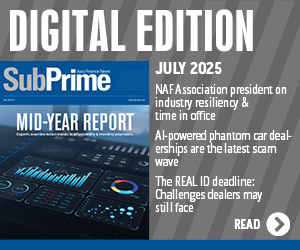TransUnion examines depth Gen Z is using auto financing

Image by Sarawut Aiemsinsuk / Shutterstock.com
Your portfolio might be filling with contract holders from Generation Z — consumers born in or after 1995. Recent research from TransUnion showed that this generation isn’t necessarily just staring at smartphone constantly. These individuals also are getting behind the wheel, and sometimes leveraging auto financing in order to do so.
“First and foremost, the interesting insight is that Gen Z consumers are interested in auto financing and are purchasing vehicles,” said Matt Komos, vice president of U.S. research and consulting for TransUnion.
“Generally, there were some anecdotes and stories about that maybe there wasn't as much of an interest in that space for younger consumers,” Komos continued during a phone conversation with SubPrime Auto Finance News. “But we are seeing that when you compare to millennials at the same age, Gen Z consumers are taking out auto loans at a higher rate.”
In the U.S., the study also compared the credit activity and performance of millennials (consumers born between 1980 and 1994) and Gen Z consumers. To have a true “apples to apples” view, TransUnion observed millennials who were between the ages of 18 and 24 years old in 2012 and Gen Z consumers who were 18 to 24 years old as of 2019, adjusted for risk and age differences.
Across traditional credit products, Komos and the study team found preferences for these two groups were broadly similar. However, a combination of finance company supply and consumer demand has caused some differences between generations.
TransUnion discovered the lower rate of unemployment during Gen Z’s young adulthood has resulted in more Gen Z adults joining the workforce rather than enrolling in school. As a result, more millennials (44%) had a student loan than Gen Z (37%).
While TransUnion acknowledged it is often assumed that younger consumers inherently present greater risk to finance companies, Komos and his fellow researchers found it interesting to note that 50% of credit-active Gen Z consumers are prime and above (with a VantageScore 661 or higher), compared to the 39% of credit-active millennials who were prime and above at the same age.
Even with a less risky credit-active population, TransUnion indicated Gen Z consumers have benefited from favorable underwriting standards toward non-prime borrowers with a VantageScore 660 and below in both the auto and credit card industries.
Komos and his colleagues noticed this underwriting expansion into riskier tiers has driven nearly 10% more credit-active Gen Z consumers into auto financing compared to millennials over the same age period. There has also been an increase of subprime (VantageScore 300-600) bankcard activity for Gen Z, as 23% of subprime consumers have a credit card in comparison to 12% of subprime millennials.
“The oldest set of Gen Z consumers came of age during an elongated economic expansion and relaxed underwriting environment, which allowed for a comparatively easier entrance into the credit market than their millennial counterparts,” Komos said.
“Gen Z has been able to access credit cards and auto loans with greater ease, particularly because lenders have been extending their buy-box into non-prime — which has been beneficial to these Gen Z consumers as they enter the credit market,” he continued.
And those previously mentioned smartphones, Komos mentioned how those devices remain important in the auto-financing market, too, when discussing Gen Z.
“Given that this is our first digital native generation, they've grown up in a digital environment,” Komos said. “That’s the way they're used to doing business.
“I think it’s important for lenders to understand the ongoing trends and preferences that these consumers are exhibiting and really try to serve them as best as possible with not just their preferred engagement protocol or method but also with valuable products and solutions that serve the needs of these consumers,” he went on to say.


